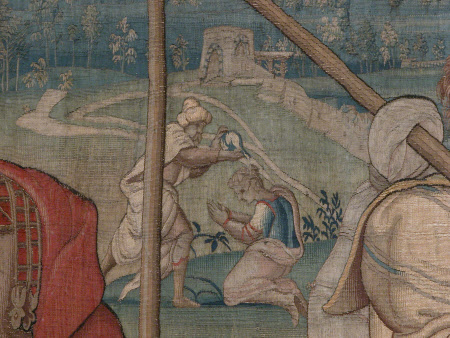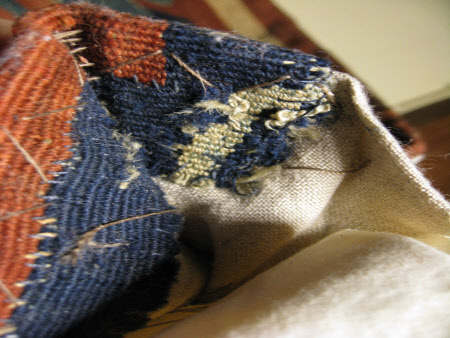The Departure of Saul
Brussels
Category
Tapestries
Date
circa 1550 - circa 1575
Materials
Tapestry, wool and silk, 5½ -6 warps per cm
Measurements
3100 x 4600 mm
Order this imageCollection
Packwood House, Warwickshire
NT 557904
Summary
Tapestry, wool and silk, 5½ -6 warps per cm, The Departure of Saul, one of two from a History of Saul, Brussels, c. 1550-1575. A large rectangular tapestry showing the departure of Saul from his father’s house, and other scenes in the background. The principal scene takes up the left hand two-thirds of the tapestry. In the centre Saul, bearded and wearing a red cloak over a leather tunic, holds a spear or staff in one hand and raises the other hand in a farewell gesture to his father who approaches from the left, bent over a stick and wearing a green cloak and a red tunic. To the right of Saul his servant, wearing a pale yellowish tunic and a red hat, sets off carrying a spear with a bundle tied to it, a purse over his shoulder and a flask in his left hand. On the left two women watch from the doorway of a building with marble pilasters. Three further scenes are enacted by small figures in the background. The borders of the tapestry are intact on all four sides and are composed of a variety of leaves, flowers and fruit over a central palm trunk; the ground fades from red to light beige and along the inner and outer edges are bands of colour imitating the carved edge of a frame.
Full description
Saul was the first king of the people of Israel, appointed by the prophet Samuel. He first appears in I Samuel 9 and is described as “a choice young man, and goodly … from his shoulders and upward he was higher than any of the people”. As in the present tapestry Saul is commonly represented as taller than those around him and in military dress which refers to his later prowess in battle. The tapestry shows Saul being sent out by his father along with a servant to search for his lost asses (I Samuel 9.3). After searching for the asses in vain Saul and his servant decided to seek out the prophet Samuel and ask his advice, planning to present him with the fourth part of a shekel of silver, which may be alluded to by the purse carried by Saul’s servant (I Samuel 9.8). On the right hand side they are seen asking directions from women fetching water (I Samuel 9.11), and being directed to the city at the top of the hill where they are seen again at the city gates. Samuel came to meet the travellers at the gates, having been told by the Lord that a man would arrive whom he should anoint to rule over the people. The anointment of Saul by Samuel (I Samuel 10.1) takes place in the background behind the principal figures of Saul and his servant. ‘The Sacrifice of Saul’, the companion to this tapestry, bears part of the mark of the city of Brussels on its lower border, and a partial maker’s mark at the bottom of the right hand edge. An even smaller fragment of the same mark survives on the present tapestry, now folded under the lining. Both maker’s marks are too mutilated to be positively identified. The two tapestries probably come from a larger set of the History of Saul, or possibly of the History of David. No further weavings of these two designs have been located but a number of stylistically similar tapestries with related subject matter survive. These include a set of six tapestries of the ‘History of Saul’ in the Cathedral of Cuenca in Spain (Junquera 1973), and a set whose subject may be a ‘History of the Kings’ but which includes two scenes from the life of Saul, in the Residenz, Munich (Duverger 1969, pp. 134-141). Both these sets bear the mark of the Brussels weaver and entrepreneur François Geubels (fl. 1546-1585), and both have borders similar to the set at Packwood. François Geubels was one of the most important tapestry weavers in mid-sixteenth-century Brussels. His mark appears on a large number of surviving sets and he frequently subcontracted part of sets to different weavers, as was the case with the tapestry sets now at Munich and Cuenca which bear the mark of a second master weaver. It is possible that the two tapestries at Packwood were woven under his direction as well. (Helen Wyld, 2009)
Provenance
The Marques of Zetland, Aske Hall; sold Tennants 21.09.1994, lot 917 and bought by the National Trust for Packwood House
Credit line
Packwood House, The Graham Baron Ash Collection (The National Trust)
Makers and roles
Brussels , workshop
References
Cinq Siècles d’Art Bruxellois: tome II, dessins et tapisseries, exh. cat. Brussels 1935 Duverger, 1969: Erik Duverger, ‘Tapijtwerk uit het Atelier van Frans Geubels’, in De Bloeitijd van de Vlaamse Tapijtkunst, Internationaal Colloquium 23-25 Mei 1961, Brussels 1969, pp. 91-149 Thomson, 1973: W G Thomson, A History of Tapestry from the Earliest Times until the Present Day, 3rd edition, Wakefield 1973 Junquera 1973 P Junquera, ‘Los Tapices de la Catedral de Cuenca’, Archivo Español de Arte, vol. XLVI, no. 181 (1973), pp. 2-8 Forti-Grazzini, 1984: Nello Forti-Grazzini, Museo d'arti applicate. Arazzi (Musei e Gallerie di Milano), Milan 1984


